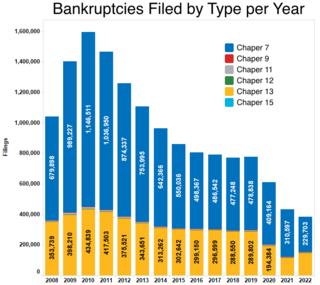
In corporate finance, a debenture is a medium- to long-term debt instrument used by large companies to borrow money, at a fixed rate of interest. The legal term "debenture" originally referred to a document that either creates a debt or acknowledges it, but in some countries the term is now used interchangeably with bond, loan stock or note. A debenture is thus like a certificate of loan or a loan bond evidencing the company's liability to pay a specified amount with interest. Although the money raised by the debentures becomes a part of the company's capital structure, it does not become share capital. Senior debentures get paid before subordinate debentures, and there are varying rates of risk and payoff for these categories.
A lien is a form of security interest granted over an item of property to secure the payment of a debt or performance of some other obligation. The owner of the property, who grants the lien, is referred to as the lienee and the person who has the benefit of the lien is referred to as the lienor or lien holder.
Title 11 of the United States Code sets forth the statutes governing the various types of relief for bankruptcy in the United States. Chapter 13 of the United States Bankruptcy Code provides an individual with the opportunity to propose a plan of reorganization to reorganize their financial affairs while under the bankruptcy court's protection. The purpose of chapter 13 is to enable an individual with a regular source of income to propose a chapter 13 plan that provides for their various classes of creditors. Under chapter 13, the Bankruptcy Court has the power to approve a chapter 13 plan without the approval of creditors as long as it meets the statutory requirements under chapter 13. Chapter 13 plans are usually three to five years in length and may not exceed five years. Chapter 13 is in contrast to the purpose of Chapter 7, which does not provide for a plan of reorganization, but provides for the discharge of certain debt and the liquidation of non-exempt property. A Chapter 13 plan may be looked at as a form of debt consolidation, but a Chapter 13 allows a person to achieve much more than simply consolidating his or her unsecured debt such as credit cards and personal loans. A chapter 13 plan may provide for the four general categories of debt: priority claims, secured claims, priority unsecured claims, and general unsecured claims. Chapter 13 plans are often used to cure arrearages on a mortgage, avoid "underwater" junior mortgages or other liens, pay back taxes over time, or partially repay general unsecured debt. In recent years, some bankruptcy courts have allowed Chapter 13 to be used as a platform to expedite a mortgage modification application.
A creditor or lender is a party that has a claim on the services of a second party. It is a person or institution to whom money is owed. The first party, in general, has provided some property or service to the second party under the assumption that the second party will return an equivalent property and service. The second party is frequently called a debtor or borrower. The first party is called the creditor, which is the lender of property, service, or money.

In the United States, bankruptcy is largely governed by federal law, commonly referred to as the "Bankruptcy Code" ("Code"). The United States Constitution authorizes Congress to enact "uniform Laws on the subject of Bankruptcies throughout the United States". Congress has exercised this authority several times since 1801, including through adoption of the Bankruptcy Reform Act of 1978, as amended, codified in Title 11 of the United States Code and the Bankruptcy Abuse Prevention and Consumer Protection Act of 2005 (BAPCPA).
Hypothec, sometimes tacit hypothec, is a term used in civil law systems or to refer to a registered real security of a creditor over real estate, but under some jurisdictions it may additionally cover ships only, as opposed to other collaterals, including corporeal movables other than ships, securities or intangible assets such intellectual property rights, covered by a different type of right (pledge). Common law has two main equivalents to the term: mortgages and non-possessory lien.
In finance, a security interest is a legal right granted by a debtor to a creditor over the debtor's property which enables the creditor to have recourse to the property if the debtor defaults in making payment or otherwise performing the secured obligations. One of the most common examples of a security interest is a mortgage: a person borrows money from the bank to buy a house, and they grant a mortgage over the house so that if they default in repaying the loan, the bank can sell the house and apply the proceeds to the outstanding loan.
In law, perfection relates to the additional steps required to be taken in relation to a security interest in order to make it effective against third parties or to retain its effectiveness in the event of default by the grantor of the security interest. Generally speaking, once a security interest is effectively created, it gives certain rights to the holder of the security and imposes duties on the party who grants that security. However, in many legal systems, additional steps --- perfection of the security interest --- are required to enforce the security against third parties such as a liquidator.
A secured loan is a loan in which the borrower pledges some asset as collateral for the loan, which then becomes a secured debt owed to the creditor who gives the loan. The debt is thus secured against the collateral, and if the borrower defaults, the creditor takes possession of the asset used as collateral and may sell it to regain some or all of the amount originally loaned to the borrower. An example is the foreclosure of a home. From the creditor's perspective, that is a category of debt in which a lender has been granted a portion of the bundle of rights to specified property. If the sale of the collateral does not raise enough money to pay off the debt, the creditor can often obtain a deficiency judgment against the borrower for the remaining amount.
An unfair preference is a legal term arising in bankruptcy law where a person or company transfers assets or pays a debt to a creditor shortly before going into bankruptcy, that payment or transfer can be set aside on the application of the liquidator or trustee in bankruptcy as an unfair preference or simply a preference.
In law, a voidable floating charge refers to a floating charge entered into shortly prior to the company going into liquidation which is void or unenforceable in whole or in part under applicable insolvency legislation.
Subordination in banking and finance refers to the order of priorities in claims for ownership or interest in various assets.

Re Spectrum Plus Ltd[2005] UKHL 41 was a UK company law decision of House of Lords that settled a number of outstanding legal issues relating to floating charges and recharacterisation risk under the English common law. However, the House of Lords also discussed the power of the court to make rulings as to the law that were "prospective only" to mitigate potential harshness when issuing a ruling that was different from what the law had previously been understood to be.

United Kingdom insolvency law regulates companies in the United Kingdom which are unable to repay their debts. While UK bankruptcy law concerns the rules for natural persons, the term insolvency is generally used for companies formed under the Companies Act 2006. Insolvency means being unable to pay debts. Since the Cork Report of 1982, the modern policy of UK insolvency law has been to attempt to rescue a company that is in difficulty, to minimise losses and fairly distribute the burdens between the community, employees, creditors and other stakeholders that result from enterprise failure. If a company cannot be saved it is liquidated, meaning that the assets are sold off to repay creditors according to their priority. The main sources of law include the Insolvency Act 1986, the Insolvency Rules 1986, the Company Directors Disqualification Act 1986, the Employment Rights Act 1996 Part XII, the EU Insolvency Regulation, and case law. Numerous other Acts, statutory instruments and cases relating to labour, banking, property and conflicts of laws also shape the subject.
Re Bank of Credit and Commerce International SA [1998] AC 214 is a UK insolvency law case, concerning the taking of a security interest over a company's assets and priority of creditors in a company winding up.
Administration in United Kingdom law is the main kind of procedure in UK insolvency law when a company is unable to pay its debts. The management of the company is usually replaced by an insolvency practitioner whose statutory duty is to rescue the company, save the business, or get the best result possible. While creditors with a security interest over all a company's assets could control the procedure previously through receivership, the Enterprise Act 2002 made administration the main procedure.

Buchler v Talbot[2004] UKHL 9 is a UK insolvency law case, concerning the priority of claims in a liquidation. Under English law at the time the expenses of liquidation took priority over the preferred creditors, and the preferred creditors took priority over the claims of the holder of a floating charge. However, a crystallised floating charge theoretically took priority over the liquidation expenses. Accordingly the courts had to try and reconcile the apparent triangular conflict between priorities.

Cayman Islands bankruptcy law is principally codified in five statutes and statutory instruments:

Re Brightlife Ltd [1987] 1 Ch 200 is a UK insolvency law case, concerning the conversion of a floating charge into a fixed charge ("crystallisation"). It held that an automatic crystallisation clause was part of the parties’ freedom of contract. It could not be limited by court created public policy exceptions. The significance of the case was largely outpaced by the Insolvency Act 1986 section 251, which said a floating charge was one that was created as a floating charge.
Bank of America, N. A. v. Caulkett, 575 U.S. 790, 135 S. Ct. 1995 (2015), is a bankruptcy law case decided by the Supreme Court of the United States on June 1, 2015. In Caulkett, the Court held that 11 U.S.C. § 506(d) does not permit a Chapter 7 debtor to void a junior mortgage on the debtor's property when the amount of the debt secured by the senior mortgage on that property exceeds the property's current market value.







